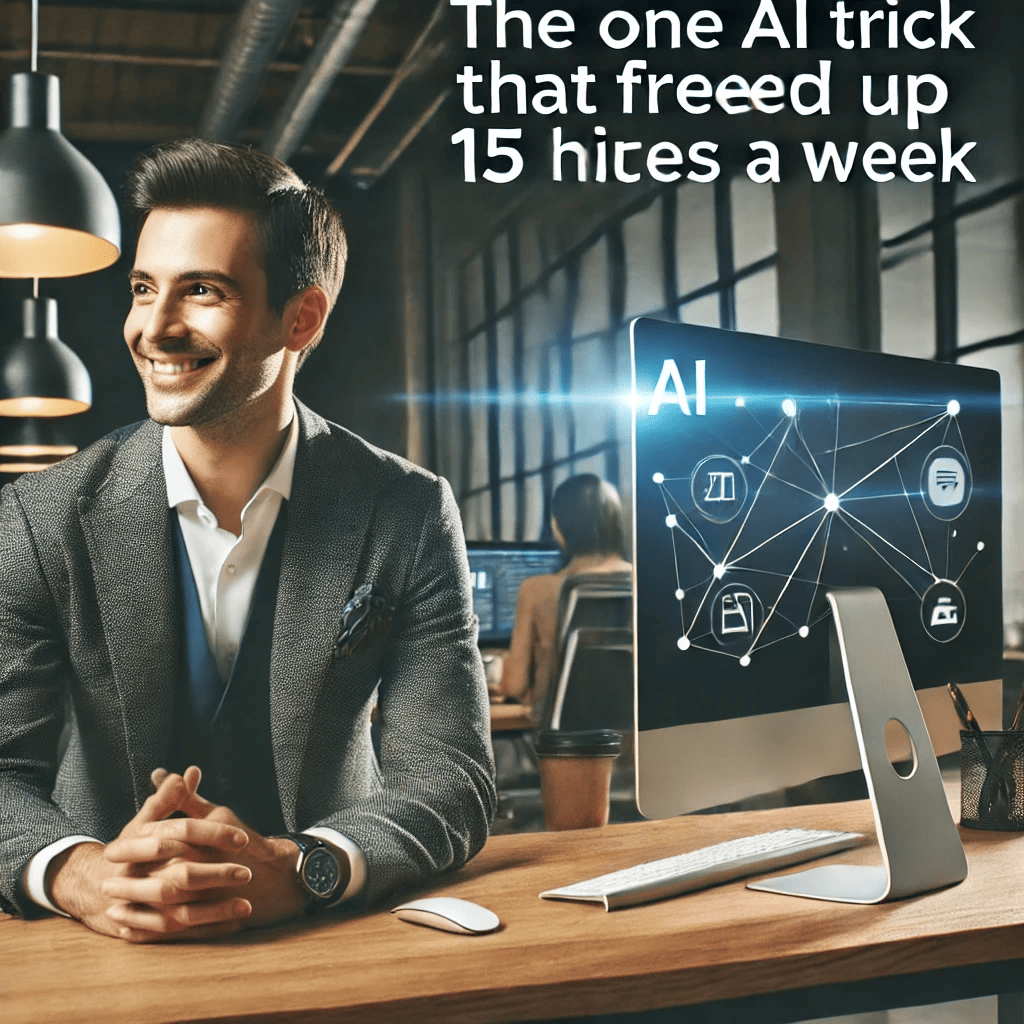The One AI Trick That Freed Up 15 Hours a Week
The one AI trick that revolutionized my productivity transformed mundane tasks into streamlined processes, freeing up an astonishing fifteen hours each week for activities that truly matter to me personally and professionally.
I experimented with various artificial intelligence tools in ways I never imagined possible, discovering that the true potential lies in crafting a personalized workflow tailored to my specific needs as an entrepreneur and writer.
For newcomers to AI integration, what follows might spark creativity in your approach, while experts may find confirmation of strategies already implemented in their routines.
The methodology I’ve developed focuses on practical applications rather than theoretical possibilities, demonstrating concrete ways automation enhances productivity across various contexts.
My journey with AI productivity began with simple experimentation, gradually evolving into a sophisticated system that now forms the backbone of my daily operations and content creation process.
What I find particularly valuable about sharing these experiences is the concept of cross-context learning – observing how someone in a different industry applies these tools and adapting those insights to your unique situation.
While my entrepreneurial lifestyle may differ from yours, the principles underlying effective AI implementation remain universally applicable across professional landscapes and personal projects.
The following strategies represent my real-world implementation of AI tools, demonstrating how they collectively save substantial time while improving output quality in tangible, measurable ways.
We strongly recommend that you check out our guide on how to take advantage of AI in today’s passive income economy.
Table of Contents
How I Use AI to Augment My Writing
The Three-Step Writing Process
My writing workflow incorporates three distinct phases, creating a seamless progression from initial ideation to polished final product ready for distribution across various platforms and mediums.
I begin by speaking my thoughts into Voice Pal, an application developed with my team that captures verbal brainstorming and transforms spoken ideas into structured text without losing the natural flow of thought.
The captured content then flows into either ChatGPT or Claude by Anthropic, where AI assistance helps refine structure, suggest improvements, and ensure clarity while maintaining my authentic voice.
Finally, the refined text moves into Notion, where I apply finishing touches, personalize elements that require human judgment, and prepare the content for its intended audience and purpose.
This process applies universally to everything I write – from weekly email newsletters and internal team communications to detailed content outlines and social media messaging strategies.
Voice Pal has become central to my ideation process, serving as a repository for thoughts captured since December 2023 when we first built the application for precisely this purpose.
What makes this system particularly effective is how it distinguishes between quick thought capture and more deliberate content development, offering flexibility based on the specific requirements of each writing task.
The interface provides two primary options – quick typing for capturing fleeting ideas and more detailed voice recording for developing substantial content that requires deeper exploration.
Example: Creating My Newsletter
For my recent newsletter focusing on procrastination strategies, I decided to explore a technique I’ve been implementing called “going through the motions” as a method for overcoming resistance.
I opened Voice Pal and began recording my thoughts about how this approach helps me overcome the emotional and cognitive barriers that typically prevent me from starting important tasks.
My initial recording explored how simply setting up my environment – adjusting my camera, preparing my appearance, organizing my space – significantly reduces the activation energy required to begin the actual work.
Voice Pal then intelligently prompted follow-up questions that helped expand my thinking: “What specific emotional barriers do you face?” and “Can you share personal anecdotes demonstrating effectiveness?”
The application continued generating relevant questions based on my responses, helping me explore variations of the technique, measurement methods, and potential applications across different contexts.
This interactive questioning process excavates ideas I might not otherwise articulate, pulling valuable insights from my experience that strengthen the final content and make it more useful to readers.
What distinguishes this approach from simply requesting AI-generated content is that the core ideas remain genuinely mine – the AI merely helps articulate, organize, and expand upon my authentic thoughts.
The technology serves as an amplifier for my thinking rather than a replacement, ensuring the final product maintains personal perspective while benefiting from AI-enhanced structure and clarity.
Refining With Multiple AI Tools
After capturing my thoughts in Voice Pal, I exported the conversation stream to evaluate the initial draft and determine which refinement approach would best serve this particular content.
For this newsletter, I copied the content to Claude, my preferred writing assistant for most projects, placing it within my dedicated “Life Notes” project to maintain organizational consistency.
When Claude’s output didn’t quite capture the tone I wanted, I tried the same content in ChatGPT, which sometimes produces better results because of its memory function and familiarity with my writing style.
This comparative approach between different AI assistants offers perspective that a single tool cannot provide, helping identify the strongest elements from each and incorporate them into the final product.
The ability to quickly generate multiple drafts from the same source material dramatically accelerates the refinement process, allowing rapid iteration without the traditional time investment of rewriting.
Once satisfied with a draft that captures approximately 80% of my vision, I transfer the content to Notion where I make final edits, adjustments, and personalizations that require human judgment.
This multi-stage process might seem complex, but it actually streamlines what was previously a two-hour writing session into approximately thirty minutes of focused, efficient content development.
The misconception many have about AI writing assistance is expecting perfection immediately – the reality involves generating multiple outputs, comparing approaches, and applying human editing to achieve optimal results.
Maintaining Authenticity
One critical element in my AI-augmented writing process is preserving authentic voice while leveraging technological assistance for structure, expansion, and refinement of core ideas.
For certain sections, particularly those requiring personal anecdotes or emotional expression, I sometimes bypass AI altogether and write directly, preserving nuances that algorithms might inadvertently sanitize.
My newsletter’s “Favorite Things” section exemplifies this approach – a deliberately personalized segment where enthusiasm, quirky observations, and subjective opinions flow naturally from direct expression.
The balance between AI assistance and direct writing creates a product that benefits from technological efficiency without sacrificing the personal connection readers expect from authentic communication.
This hybrid approach acknowledges that while AI excels at certain aspects of content development, human expression remains essential for conveying genuine emotion, building connection, and expressing individuality.
For generating potential email subject lines, I use Notion AI’s suggestion feature, activating it with Command+J to request multiple options that I can quickly evaluate and select.
I often compare these suggestions with alternatives from Claude or ChatGPT, giving me diverse perspectives on what might resonate most effectively with my audience for any given topic.
The result combines technological efficiency with human discernment, creating content that neither pure AI generation nor unassisted human writing could achieve independently with the same quality and speed.
Using AI for Data Analysis
Transforming Analytics into Actionable Insights
Another significant time-saving application in my workflow involves using AI to analyze data spreadsheets, transforming raw information into strategic recommendations that inform decision-making.
Whenever I encounter structured data – particularly CSVs or spreadsheets containing performance metrics, audience insights, or financial information – AI tools dramatically accelerate the analysis process.
Rather than manually examining patterns, calculating statistics, or visualizing trends, I provide the raw data to ChatGPT or Claude along with specific analytical objectives I want to accomplish.
This approach recently proved invaluable when planning content strategy based on YouTube analytics, allowing me to identify patterns in viewer engagement that would have taken hours to recognize manually.
I downloaded a CSV file containing 365 days of channel analytics, uploaded it to Claude, and requested analysis focusing specifically on identifying potential video topics likely to maximize views and subscriber growth.
Claude quickly processed the information and provided actionable recommendations, including ideal video length (30-40 minutes based on historical performance) and high-potential topic categories.
The suggested videos reflected patterns from top-performing content while incorporating current trends, creating a strategically sound content plan based on objective performance data rather than subjective assumptions.
When seeking deeper insights, I prompted Claude to provide “level two and three responses,” resulting in more sophisticated analysis including title structure matrices and micro-optimization recommendations.
The Progressive Depth Approach
This progressive depth approach to AI analysis represents one of my favorite techniques – starting with surface-level insights and systematically probing deeper through increasingly sophisticated analytical lenses.
Level one analysis typically provides straightforward observations and basic recommendations based on obvious patterns in the data, serving as a foundation for more nuanced exploration.
Level two delves into correlations between multiple variables, identifying less obvious relationships between content characteristics, audience demographics, and performance metrics that inform strategic planning.
Level three reaches into predictive territory, combining historical patterns with current trends to forecast potential outcomes for different content approaches and audience targeting strategies.
This methodical progression transforms raw data into a decision-making framework that balances historical performance with emerging opportunities, reducing uncertainty in strategic planning.
The entire process typically reduces what would be several hours of manual analysis into minutes of interaction with the AI, followed by focused evaluation of the generated insights.
Beyond time savings, this approach often reveals insights I might miss through manual analysis, as the AI systematically examines all variables without the confirmation bias that sometimes influences human analysis.
The result is decision-making grounded in comprehensive data interpretation rather than selective observation, creating more reliable strategic foundations for content development and audience engagement.
AI as Personal Assistant in Daily Life
Travel Companion and Tour Guide
My AI implementation extends well beyond professional applications, serving valuable functions in personal contexts that enhance experiences and solve everyday challenges creatively.
During a recent trip to Taiwan with my wife – our final holiday before welcoming our first child – Claude became our personalized tour guide, providing contextual information that enriched our exploration.
While standing in Liberty Square (formerly Chiang Kai-shek Square) in Taipei, I described the enormous identical buildings we observed and asked Claude to identify our location and explain its significance.
Claude immediately provided historical context about the National Theater and National Concert Hall, enhancing our appreciation of the architectural and cultural significance beyond what standard guidebooks offer.
This contextual understanding extended to economic questions about Taiwan’s semiconductor industry dominance, with Claude explaining the fascinating historical development from 1970s strategic planning to global leadership.
The AI assistance proved particularly valuable for understanding cultural practices, such as when we observed people throwing moon blocks in a temple and needed explanation of this traditional divination practice.
What made Claude particularly effective as a travel companion was the minimal friction in interaction – the single-click voice interface allowed natural, conversational engagement without disrupting our exploration.
This seamless interaction contrasts with ChatGPT’s two-step process (transcribe then send), demonstrating how interface design significantly impacts the practical utility of AI tools in dynamic real-world settings.
Culinary Problem Solving
AI assistance extends into practical everyday challenges, such as when I needed recipe suggestions for a pregnant spouse who loves sushi but couldn’t consume raw fish due to pregnancy restrictions.
Rather than spending time researching pregnancy-safe sushi alternatives across multiple cooking websites, I simply described the situation to my AI assistant and received customized recommendations immediately.
The response included creative cooked seafood options, vegetable-based alternatives, and preparation techniques that preserved the essence of the sushi experience while ensuring safety during pregnancy.
This application demonstrates how AI transforms mundane research tasks into efficient conversations, providing personalized solutions to specific situations without extensive searching or comparison.
The contextual understanding these tools demonstrate allows them to factor in multiple constraints simultaneously – in this case, culinary preferences, dietary restrictions, and preparation complexity.
While each individual time-saving instance might seem modest, collectively they represent significant reclamation of time and mental bandwidth across numerous daily decision points and information needs.
This accumulation of small efficiencies creates the substantial time savings – approximately fifteen hours weekly – that the integrated AI approach ultimately delivers across professional and personal contexts.
The key lies in recognizing opportunities where AI assistance can eliminate friction in everyday processes, from significant research tasks to momentary information needs that arise throughout the day.
Conclusion
The Cumulative Impact of AI Integration
The integration of artificial intelligence across my workflow has transformed productivity not through a single dramatic intervention but through the cumulative effect of dozens of small optimizations.
Writing assistance, data analysis, information retrieval, decision support, and problem-solving all benefit from AI augmentation, creating a comprehensive ecosystem of enhanced productivity that preserves authenticity.
What began as experimental implementation has evolved into a sophisticated productivity infrastructure that fundamentally changes how I approach both creative and analytical tasks throughout my week.
The fifteen hours reclaimed weekly represents time redirected toward high-value activities that AI cannot replicate – strategic thinking, relationship building, and creative exploration that delivers genuine value.
For those beginning their AI productivity journey, I recommend starting with a single workflow – perhaps writing or data analysis – and gradually expanding implementation as you discover what delivers the greatest personal benefit.
Focus on augmentation rather than replacement, using AI to enhance your natural strengths while compensating for limitations, creating a complementary relationship rather than delegating creative responsibility.
Experiment across multiple tools rather than committing exclusively to a single platform, as different AI assistants demonstrate unique strengths that become apparent through comparative implementation.
Most importantly, maintain a learning mindset, recognizing that effective AI implementation evolves continuously as both the technology and your understanding of its optimal application develop over time.
Practical Implementation Tips
Getting Started With AI Productivity
Begin your AI productivity journey by identifying repetitive, time-consuming tasks in your current workflow that don’t require uniquely human judgment or creativity to complete effectively.
Consider implementing voice-to-text technology as an entry point, particularly if you process substantial written communication or documentation that could benefit from speaking rather than typing.
Experiment with multiple AI assistants (ChatGPT, Claude, etc.) to discover which interface and reasoning approach aligns best with your thinking style and typical information processing needs.
Start with straightforward applications like editing assistance, summarization, or information retrieval before progressing to more complex implementations involving multiple tools working together.
Reserve direct human effort for elements requiring emotional intelligence, creative originality, or ethical judgment while delegating research, organization, and preliminary drafting to AI assistance.
Develop prompt templates for recurring tasks, creating standardized instruction formats that consistently produce results aligned with your expectations and requirements across various projects.
Implement periodic review of your AI productivity system, evaluating which elements deliver meaningful value and which might benefit from refinement or replacement with alternative approaches.
Remember that effective AI implementation resembles a partnership rather than delegation, requiring thoughtful direction and discerning evaluation rather than uncritical acceptance of generated content.
Common Pitfalls to Avoid
The most frequent mistake in AI implementation involves expecting perfection immediately, overlooking the iterative nature of effective assistance that typically involves multiple refinement cycles.
Excessive reliance on AI for creative inception rather than development and refinement can diminish authenticity and originality, particularly in content that requires genuine personal perspective.
Neglecting comparative evaluation across multiple AI platforms limits exposure to diverse approaches and reasoning models that collectively provide more comprehensive assistance than any single tool.
Failure to maintain appropriate security protocols when sharing sensitive information with AI assistants can create privacy vulnerabilities that compromise confidential personal or business information.
Over-automation of processes requiring nuanced human judgment may create efficiency at the expense of quality, particularly in communication requiring emotional intelligence or cultural sensitivity.
Neglecting to periodically reassess implementation as both technology and personal needs evolve can result in outdated workflows that fail to leverage emerging capabilities or address changing requirements.
Focusing exclusively on time savings without considering quality improvements may miss opportunities where AI can enhance outcomes beyond what unassisted human effort could reasonably achieve.
Implementing complex multi-tool solutions before mastering fundamental applications often creates unnecessary complication that diminishes overall productivity rather than enhancing it strategically.

We strongly recommend that you check out our guide on how to take advantage of AI in today’s passive income economy.




